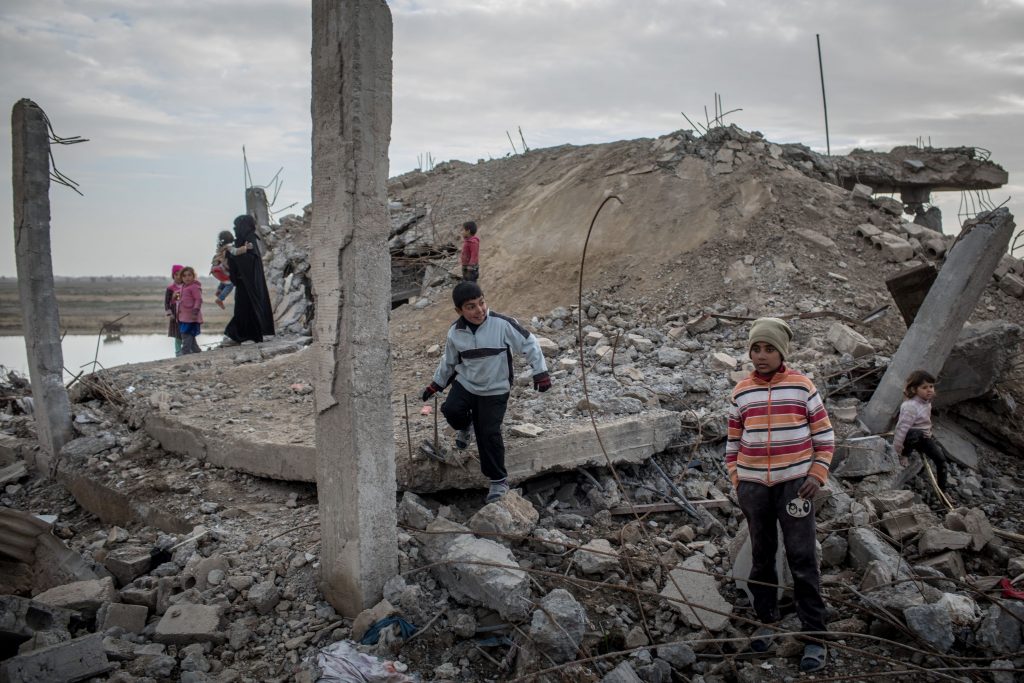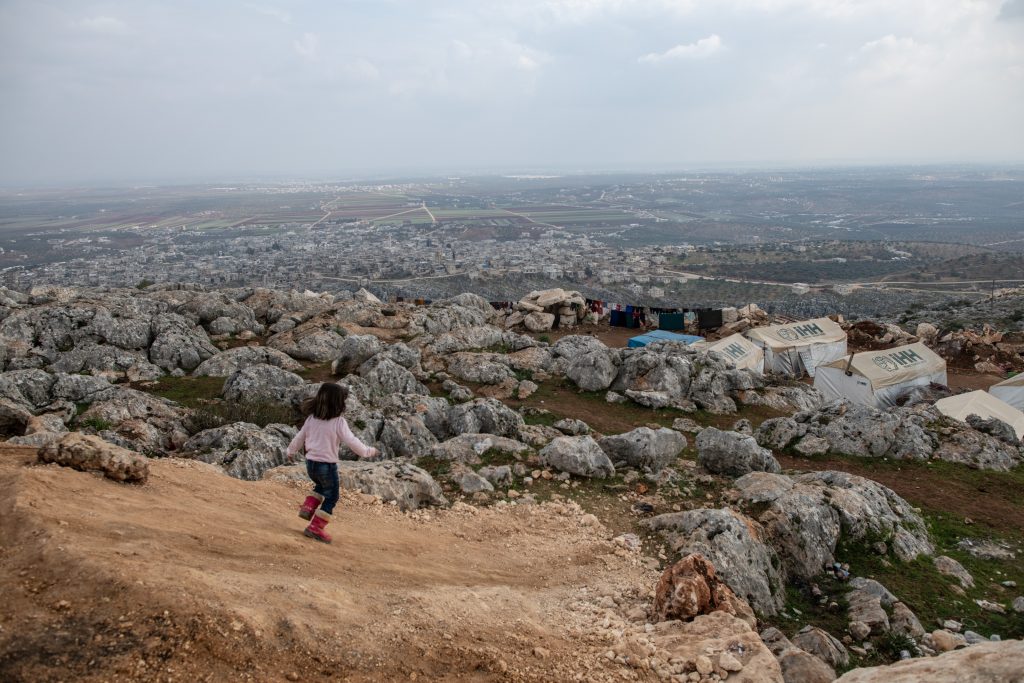Syrians are mourning one of the most tragic episodes in the country’s rich history: a revolution that began peacefully in 2011 only to end in all-out war. This “dirty war” has had devastating impacts on the country and its population.1 Approximately 600,000 people have been killed, and 12 million (more than half of the prewar population) forced out of their homes.2 There has been an estimated cumulative decrease in GDP of $324.5 billion; the annual output of the economy is 54 percent smaller than it was in 2010.3 Patterns of human insecurity intensified during the war, accentuating drastic regional disparities, threatening the livelihoods of already precarious populations, and cutting off millions from their communities and social services. These effects were only made worse by the increased corruption and predation of new networks of profit that accompanied the war economy, entrenching political and economic domination by the military and security services alongside crony businessmen.4
Yet one clear threat to human security is often ignored when assessing the human toll of armed conflict: the deterioration of natural resources and, more broadly, the cost of environmental degradation. This report identifies the set of challenges to environmental and human security that an almost decade-long conflict has exacted on Syria, and asks how they have affected populations, and what challenges lie ahead for lasting recovery.
There is an ongoing debate in policy and academia on the meaning of the environment for security concerns. Understanding these debates can offer conceptual tools for policymakers to craft sustainable reconstruction efforts in Syria. This report outlines the development of environmental security as a concept, and then uses the framework to analyze the Syrian conflict, before offering several brief proposals on how it can be applied by interested parties.
Why Environmental Security?
At the end of the Cold War, nontraditional security studies started to broaden agendas beyond military and economic threats to include energy-related and environmental concerns. Scholars originally defined environmental security in exclusively realist terms, focusing on threats to the state and invoking narratives about wars and insurrections that could arise from conflict over diminishing resources.5
In turn, scholarly work on environmental security flourished within two categories. First, such work explored narratives that questioned how environmental change related to violent conflict and the integrity of the state.6 Second, it examined the broader implications of environmental issues, in which the concept of security refers to other entities besides the state. The concept of security gradually moved away from states and toward networks of individuals and nonstate actors.
Similarly, some scholars argued in favor of a kind of security that went even further—one that considered questions of human security and environmental well-being.7 This turn was a key inflection point informing different views of environmental and climate security: some saw the environment as a trigger of conflict and insecurity, while others saw the environment as the object of security itself.
In this new security framework, the environment is not a freely existing trove of natural resources to be fought over and monetized, but rather encompasses the physical factors that condition human affairs and well-being.
In this new security framework, the environment is not a freely existing trove of natural resources to be fought over and monetized, but rather encompasses the physical factors that condition human affairs and well-being. Environmental security, in this definition, encompasses the means and processes that seek to reduce or prevent the environmental consequences of war, natural disasters, erosion of the earth’s carrying capacity, and armed conflict—including war that itself results from environmental change.8 The concept of environmental security, then, is a critical evolution in the theory of security. This perspective attempts to move security closer to its simplest form: the desire to prolong and improve life on the planet.
The inclusion of environmental concerns in security discourses doesn’t just force academics, analysts, and practitioners to broaden the consideration of potential threats. Significantly, it also requires them to consider who or what is being threatened. A human-centered perspective is, therefore, helpful for sustainable postconflict recovery.
The concept of environmental security also encourages countries to find regional and national policy solutions to environmental threats. These solutions can prioritize sustainable environmental protection, and the safety, well-being, and livelihoods of citizens in situations of armed conflict. Most importantly, this perspective seeks not only to protect vulnerable populations, but also to identify the unequal power structures that cause or encourage their suffering. In the case of Syria, local populations continue to face a myriad of threats that feed on a dysfunctional state and the general lack of governance.
Livelihoods in Crisis
One of Syria’s most acute challenges today is the water and food crisis. In the decade preceding the eruption of conflict in 2011, the severe stress on water and land resources magnified existing inequities—producing a ticking bomb. But the combined effects of climate change, drought, and massive migration by rural communities in northeastern Syria did not produce the protests; the unemployed farmers—the biggest casualties of the drought—were not the instigators of the 2011 Syrian uprisings. The structural seeds of conflict were planted by unsustainable government practices, which aggravated poverty and food insecurity.9 Such pressures on water and food security were already playing out in a context of intensive irrigation dating back to the 1970s, increased poverty, low wages, high unemployment, and rising corruption. Conflict became an increasingly likely scenario once the government had removed agricultural and fuel subsidies, and privatization of the economy was well underway, in the middle to end of the first decade of the new century.
The war intensified such disparities and patterns of human insecurity. It also paved the way for lucrative war economies, in which pro- and anti-regime elites carried out smuggling and extortion rackets in exchange for the supply of food, water, and fuel to local populations.
The conflict’s toll on crops and land gradually decimated Syria’s agriculture. The sector has shrunk more than 40 percent since 2011, with losses amounting to $16 billion.10 The severe shortage of farm laborers is adding to the crisis. The damages that airstrikes have inflicted to water and wastewater treatment infrastructures, combined with a lack of maintenance, have also resulted in a 50 percent decrease in the Syrian population’s access to safe water. In 2019, it was estimated that 15.5 million Syrians (more than 90 percent of the current population, which has shrunk 3 percent a year since 2011) lacked access to safe water sources, which has spread waterborne diseases.11 Leakages from wastewater pipes have increased groundwater contamination. Adding to the population’s hardship, the Syrian pound lost 95 percent of its value, relative to the U.S. dollar, between 2011 and 2020. This inflation caused skyrocketing prices for fodder products and subsidized food goods, such as rice, tea, sugar, sunflower oil, and bread. The government once sold these items, but could no longer do so as imports drastically decreased.12 According to government estimates, households now require a monthly income of 325,000 Syrian pounds to meet basic needs—while the average salary is about 40,000 pounds.13 The price of the standard food basket increased by 251 percent between 2019 and 2020. The World Food Programme estimated in May 2020 that 9.3 million Syrians are experiencing food insecurity.14 The formation of long lines to get bread has become a daily scene in Damascus. In the words of Syrian writer Yassin al-Haj Saleh, Syrians are now facing an “imminent threat of famine.”15
In the past few months, Syria and its 1 million internally displaced people, like many conflict-stricken and impoverished countries in the Global South, confronted another major threat: the extremely rapid spread of COVID-19. The amplified risk of the pandemic in Syria is part of a deadly feedback loop of mounting pressures on livelihoods, with lockdown restrictions increasing poverty and unemployment.16 The disease has quickly spread through the country and refugee camps, and its incidence is widely considered to be underreported.
While these examples illustrate the tragic legacy of the war on the livelihoods and resources of Syrians, they must also be examined in the context of environmental threats. The conflict decimated and displaced large swaths of the population; it also created serious environmental and health impacts for the survivors, some visible and others less apparent.
Oil Spills, Rubble, and More
Between 2012 and 2017, both state and nonstate actors, such as the Islamic State, weaponized Syria’s major oil pipelines and main hydroelectric dams, including the Tabqa and Tishrin Dams on the Euphrates River.17 Today, Islamic State remnants continue to target oil fields in the desert of Homs governorate.18 External powers have also extended their grip over Syrian oil fields in the central, eastern, and northeastern regions (Russia and the United States being active in the latter two regions, respectively). Meanwhile, Iran has resumed its oil exports to Syria.19

Aerial bombardments have polluted groundwater and created severe air pollution. In 2015–19, the Syrian government and Russia carried out intensive air campaigns against rebel groups, and the United States led bombardments of Islamic State-held facilities. These attacks damaged about 250 installations in the region of Deir al-Zour, and resulted in large oil and wastewater spills.20 More insidiously, these operations forced civilians to turn to an estimated 10,000 unsafe “makeshift refineries” in northwestern Syria, set up to compensate for the loss of professional oil production, and operated in part by displaced and poorly paid children and teenagers.21
Civilians have been forced to turn to an estimated 10,000 unsafe “makeshift refineries” in northwestern Syria, set up to compensate for the loss of professional oil production, and operated in part by displaced and poorly paid children and teenagers.
The rush to capture the country’s strategic minerals (oil, gas, phosphate, and chrome), forests, and agricultural lands has also created new vulnerabilities for Syrians. Since 2017, illegal logging has accelerated deforestation in Aleppo, Hama, and northeastern Idlib governorates, impacting biodiversity and the population’s ability to cook and heat itself.22 Lack of fuel also accelerated deforestation in western Syria, as displaced populations sought other means to generate heat.23 In September 2020, massive fires that decimated large nature reserves between Lattakia, Hama, and Tartous were believed to originate from criminal groups, eager to sell forest products to Russian investors—the state allows logging in burned areas.24 The fires incinerated farmers’ crops within days of the harvesting season.
The Syrian military’s indiscriminate and illegal use of sarin and chlorine gas in the Eastern Ghouta suburb of Damascus in 2013 and 2018, and in Hama in 2017, has been widely documented and condemned for its catastrophic impacts on local populations and resources.25 Yet conventional munitions and the systematic targeting of oil and sewage facilities also cause significant environmental health impacts. Explosive weapons leave a heavy toxic footprint behind for civilians who have already endured years of bombing. It is estimated that the remaining unexploded ordnances, including landmines, which have killed thousands of civilians in Raqqa and Aleppo, will take fifty years to be cleared.26 Mixed with medical and industrial waste that contains hazardous chemicals and heavy metals, the uncollected debris continues to kill by spreading pollution and diseases.27
The Need for Human and Green Recovery
International actors and organizations involved in the Syrian reconstruction effort must pursue programs and policies that tackle environmental security holistically. This requires an approach that considers three key issues: structural inequalities, immediate environmental relief to vulnerable populations, and a critical approach to the environmental impacts of reconstruction itself. First, international donors and organizations must pay attention to the structural causes of environmental security when they provide relief and resources, or risk replicating the very sources of human insecurity. Rather than building human resilience, the current postwar “reconstruction” phase is paving the way for regime resilience and war profits for external powers—based on the very structural inequalities that accentuate environmental hazards while increasing the broader population’s vulnerability. Individuals and organizations must think critically about whether their programs empower elites or foster resilience among local communities. A failure to confront the cartels of war profiteering will render all efforts, however well intentioned, merely palliative but not reconstructive.

Second, vulnerable communities require immediate and transparent communication and intervention on environmental risks and hazards to ensure their resilience and survival. This notion of human and environmental resilience is critical: it shows how societies and community units respond to and are able to cope with such risks and changes. Grave impacts on human welfare were incurred in Syria by the damages inflicted to environmental infrastructures and the health hazards posed by explosive and chemical weapon use. Left unmanaged, these impacts risk posing a serious threat to the country’s stability and the recovery of its population. Today, Syrians are not given the means of their resilience. They are displaced and exiled, subjected to intensive airstrikes in parts of the country (such as Idlib), occupied by Turkey, Russia, and the United States in other areas, at the mercy of severe groundwater and air pollution, and suffering from deadly diseases. Harm to civilians from the environmental hazards of war is often unassessed and disregarded in rehabilitation plans. The costs of environmental damage and health risks should, therefore, be thoroughly assessed and included in future recovery plans. These assessments can, in turn, spark more concrete assessments within governments and aid organizations about how to incorporate environmental sustainability into their programming. Regional and international action should commit to environmental assistance alongside humanitarian intervention, with postconflict arrangements that include natural resource management to avoid scrambles that reward war profiteers.
Regional and international action should commit to environmental assistance alongside humanitarian intervention, with postconflict arrangements that include natural resource management to avoid scrambles that reward war profiteers.
Third, organizations must view the environmental sustainability of reconstruction as inseparable from its efficacy. Environmental health is a crucial aspect of postwar reconstruction. Organizations are lobbying for the enforcement of international legal principles for the protection of civilians from toxic waste produced by military operations, and the protection of the environment during armed conflicts.28 (Organizations active in this push include the International Committee of the Red Cross, the United Nations Environmental Assembly, and civil society efforts like the Toxic Remnants of War Network.)29 Yet meaningful domestic and international action remains in its early stages in Syria, with the extent and mechanisms of local reconstruction efforts remaining opaque. The United Nations Development Programme has committed to waste collection programs in large cities. But results remain unclear for regime- and opposition-affiliated recovery funds dedicated to rubble removal—in Aleppo, Eastern Ghouta, other suburbs of Damascus, Homs, and Raqqa.30 Moreover, lessons learned from other conflicts, such as in Gaza and Lebanon, serve as a warning. Environmental harms can equally be inflicted during reconstruction, when mining and quarries create toxic extractive waste and pollute groundwater.31 Once actors take concrete measures to curtail exploitative structural forces and provide immediate relief to vulnerable populations, then homes, infrastructure, and utility services must be built sustainably from the ground up.
In Syria, the road to postwar recovery will be long and difficult. Sustainable resilience for Syria’s deeply wounded society and people will depend on the approach that the country and the world take to addressing the war’s environmental legacy.
The author wishes to thank her students for their valuable support on this report—Dahlia Elgonemy for research assistance and Jérémie Langlois and Elliot Mack for reviewing and editing.
This report was written with support from the Rockefeller Brothers Fund as part of the TCF initiative “Nature and National Security in the Middle East.”
header photos: A man sitting by the Barada River in Damascus, Syria, circa 1880, in a colorized version of a photograph by Felix Bonfils. The rivers that Syrian farmers once depended on have become unpredictable. Source: Hulton Archive/Getty Images
Notes
- The term “dirty war” is taken from “In Syria, the Environmental Toll of War Beginning to Emerge,” Fanack.com, December 3, 2019, https://fanack.com/pollution-in-the-middle-east-and-north-africa/syria-the-environmental-toll-of-war-beginning-to-emerge/.
- Numbers of dead come from the Syrian Observatory for Human Rights (SOHR). The figure of 600,000 does not include the estimated 88,000 civilians who died under torture in the regime’s prisons, “the 3,200 abducted civilians and fighters in the prisons the ‘Islamic State’ organization, or the fate of more than 4,100 prisoners and missing members of the regime forces and loyalist militiamen, and more than 1,800 persons kidnapped by rebel and Islamic factions, ‘Islamic State’ organization and Fateh al-Sham Front (former Jabhat Al-Nusra) on charges of loyalty to the regime.” From “Syrian Revolution Nine Years On: 586,100 Persons Killed and Millions of Syrians Displaced and Injured,” SOHR, March 15, 2020, https://www.syriahr.com/en/157193/.
- See “Poverty and Equity Data Portal (1990–2015) Syria,” World Bank, 2019, http://povertydata.worldbank.org/poverty/country/SYR; “Syria at War: 8 Years On,” United Nations Economic and Social Commission for Western Asia (ESCWA), September 23, 2020, https://reliefweb.int/report/syrian-arab-republic/syria-war-eight-years; Sharmila Devadas, Ibrahim Elbadawi, and Norman V. Loayza, “Growth after War in Syria,” World Bank, August, 2019, http://documents1.worldbank.org/curated/en/424551565105634645/pdf/Growth-after-War-in-Syria.pdf.
- Joseph Daher, “The Political Economic Context of Syria’s Reconstruction: A Prospective in Light of a Legacy of Unequal Development,” European University Institute, 2018, http://hdl.handle.net/1814/60112.
- John Vogler, “International Relations Theory and the Environment,” in Global Environmental Politics, Concepts, Theories and Case Studies, ed. Gabriela Kütting (New York: Routledge, 2018), 11–26, https://doi.org/10.4324/9781315179537.
- Ibid.
- Simon Dalby, “Scenarios of Doom: From Thomas Malthus to Ecological ‘Collapse,’” in Security and Environmental Change, ed. Simon Dalby (Cambridge: Polity Press, 2009), 13–35.
- Ibid.
- Marwa Daoudy, The Origins of the Syrian Conflict: Climate Change and Human Security (Cambridge: Cambridge University Press, 2020), https://doi.org/10.1017/9781108567053.
- Daher, “The Political Economic Context of Syria’s Reconstruction,” 11.
- ESCWA, “Syria At War,” 27, 34.
- “Rate of the Syrian Dollar in the Syrian Forex Market 2011–20,” The Syria Report, September 2, 2020, https://www.syria-report.com/library/economic-data/rate-us-dollar-syrian-forex-market-2011-20; “Shortages and Currency Depreciation Hike Prices of Fodder Products,” The Syria Report, June 10, 2020, https://www.syria-report.com/news/food-agriculture/shortages-and-currency-depreciation-hike-prices-fodder-products; “Pound Devaluation Raises Prices of Subsidized Food Items,” The Syria Report, July 8, 2020, https://www.syria-report.com/news/economy/pound-devaluation-raises-prices-subsidised-food-items; “Government Faces Various Challenges to Meet Food Import Needs,” The Syria Report, August 12, 2020, https://www.syria-report.com/news/economy/government-faces-various-challenges-meet-food-import-needs.
- “Expense Needs Well Above Revenues as Statistics Bureau Estimates Food Insecurity,” The Syria Report, March 26, 2019, https://www.syria-report.com/news/economy/expense-needs-well-above-revenues-statistics-bureau-estimates-food-insecurity.
- “Currency Collapse Increases Social and Political Risks,” The Syria Report, June 10, 2020, https://www.syria-report.com/news/economy/currency-collapse-increases-social-and-political-risks ; “Oil Shortages Push Public Transport Fares Higher,” The Syria Report, September 16, 2020, https://www.syria-report.com/news/transport/oil-shortages-push-public-transport-fares-higher
- Yassin al-Haj Saleh, “State of Starvation”,” Al-Jumhuriya, August 19, 2020, https://www.aljumhuriya.net/en/content/state-starvation.
- Beatrice Mosello et al., “Spreading Disease, Spreading Conflict?: COVID-19, Climate Change and Security Risks,” Climate Security Expert Network, October, 2020, https://www.climate-diplomacy.org/publications/spreading-disease-spreading-conflict-covid-19-climate-change-and-security-risks; COVID-19 Update,” The Syrian Observer,” August 27, 2020, https://syrianobserver.com/EN/news/60165/covid-19-update-7.html; Sham Network, “Refugee Camp Data Reveals Challenges and Needs Amid Coronavirus,” The Syrian Observer, July 15, 2020, https://syrianobserver.com/EN/news/59224/refugee-camp-data-reveals-challenges-and-needs-amid-coronavirus.html; “Medic in Syria Warns of ‘Unprecedented Catastrophe’ from COVID-19 amid Underreporting by Regime,” The Syrian Observer, August 28, 2020, https://syrianobserver.com/EN/news/60171/medic-in-syria-warns-of-unprecedented-catastrophe-from-covid-19-amid-underreporting-by-regime.html.
- Marwa Daoudy, “Water Weaponization in the Syrian Conflict: Strategies of Domination and Cooperation,” International Affairs 96, no. 5 (2020): 1347–66.
- “ISIS Revives in Homs Desert, Hit Iran Militants and Oil Fields,” The Syrian Observer, December 23, 2019, https://syrianobserver.com/EN/news/55071/isis-revives-in-homs-desert-hit-iran-militants-and-oil-fields.html.
- Fanack.com, “In Syria, Environmental Toll of War”; “U.S. Company Investment in Syria’s Oil Sector Cements SDF Control Over Northeast Syria,” The Syria Report, August 5, 2020, https://www.syria-report.com/news/oil-gas-mining/us-company-investment-syria%E2%80%99s-oil-sector-cements-sdf-control-over-northeast-syri; “Ministry of Oil Signs Three Contracts with Russian Companies,” The Syrian Observer, September 5, 2019, https://syrianobserver.com/EN/news/52756/ministry-of-oil-signs-three-contracts-with-russian-companies.html; “Iranian Oil Supplies Resume,” The Syria Report, June 10, 2020, https://www.syria-report.com/news/oil-gas-mining/iranian-oil-supplies-resume.
- Fanack.com, “In Syria, Environmental Toll of War;” “Amidst the Debris: Environmental Impact of Conflict in Syria Could Be Disastrous,” PAX, November 4, 2015, https://www.paxforpeace.nl/stay-informed/news/amidst-the-debris-environmental-impact-of-conflict-in-syria-could-be-disastrous; Jennifer Dathan, “The Reverberating Environmental Effects of Explosive Weapon Use in Syria,” Action on Armed Violence (AOAV), February 6, 2019, https://aoav.org.uk/2019/environmental-effects-syria/.
- Wim Zwijnenburg, “Scorched Earth and Charred Lives,” PAX, September 5, 2016, https://www.paxforpeace.nl/publications/all-publications/scorched-earth-and-charred-lives.
- Ayn al-Madina, “As Winter Sets In, Desperate Traders, Rebels Drain Forest Wealth in Liberated Areas,” The Syrian Observer, October 27, 2017, https://syrianobserver.com/EN/features/21974/as_winter_sets_in_desperate_traders_rebels_drain_forest_wealth_liberated_areas.html.
- Fanack.com, “In Syria, Environmental Toll of War.”
- “Who Started Syria’s Forest Fires?,” The Syria Report, September 16, 2020, https://www.syria-report.com/who-started-syria%E2%80%99s-forest-fires.
- “OPCW Accuses Syrian Military of Using Chemical Weapons in Hama,” The Syrian Observer, April 9, 2020, https://syrianobserver.com/EN/news/57261/opcw-accuses-syrian-military-of-using-chemical-weapons-in-hama.html; “Syria War: What We Know about Douma ‘Chemical Attack,’” BBC, July 10, 2018, https://www.bbc.com/news/world-middle-east-43697084; “Report of the Independent International Commission of Inquiry on the Syrian Arab Republic,” United Nations General Assembly Human Rights Council, A/HRC/36/55, September 29, 2017, https://undocs.org/A/HRC/36/55.
- Dathan, “ Reverberating Environmental Effects of Explosive Weapon Use in Syria.”
- Fanack.com, “In Syria, Environmental Toll of War”; PAX, “Amidst the Debris.”
- Wim Zwijnenburg, “The Human Cost of War’s Environmental Impact,” Syria Untold, October 11, 2016, https://syriauntold.com/2016/10/11/the-human-cost-of-wars-environmental-impact/.
- Toxic Remnants of War Network, http://www.trwn.org/.
- “Syrian Towns and Provinces Award Contracts for Rubble Removal,” The Syria Report, October 30, 2018, https://www.syria-report.com/news/real-estate-construction/syrian-towns-and-provinces-award-contracts-rubble-removal; “Manfoush Expands Business to Rubble Removal,” The Syria Report, May 28, 2019, https://www.syria-report.com/news/real-estate-construction/manfoush-expands-business-rubble-removal; “Three New Projects Funded by Opposition-affiliated Recovery Fund,” The Syria Report, September 25, 2019, https://www.syria-report.com/news/economy/three-new-projects-funded-opposition-affiliated-recovery-fund.
- Zwijnenburg, “The Human Cost of War’s Environmental Impact.”










